Whiteville
Houses within 15km of this house
Displaying 81 houses.
Houses within 15km of Whiteville
Displaying 81 houses.
| House name | Description | |
|---|---|---|
| Knockanacree Wood House | A house valued at £17+, occupied by Hawtrey Andrews and held from the Reverend Frederick F. Trench in the mid 19th century. Walford states that Hawtrey Andrews was the second son of Maunsell Andrews of Rathanny. This house is now demolished. | |
| Fort William | The Ordnance Survey Name Books refer to correspondence with John Cooke in the parish of Glenkeen in 1840. This house was occupied by Mrs Margaret Cooke in the mid 19th century and held from the Earl of Portarlington, valued at £13.10 shillings. John W. Cooke was resident here in the 1870s. Fort William is still extant and occupied. |
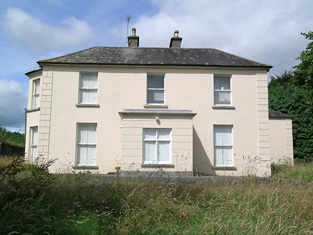
|
| Summerhill | Richard Bourke was resident at Summer-hill, Burris-o-leagh, in 1814 but by 1837 J.H. Harden was the proprietor. At the time of Griffith's Valuation Charles F. Harden held the house, valued at £11, from John H. Harden. Buildings are still extant at this site. | |
| Bouladuff | A house beside the main road from Thurles to Borrisoleigh, occupied by Thomas O'Meara and held from the Earl of Clonmel in the mid 19th century, when the buildings were valued at £12.13 shillings. The Ordnance Survey Name Books also note it as the residence of "Mr. Thomas Omar". |

|
| Dovea | A house built circa 1830s and occupied by J. Trant in 1837. The Ordnance Survey Name Books describe it as "a handsome residence" in 1840, though it mentions Mr. Ellis as the actual resident. John Trant held the property in fee at the time of Griffith's Valuation when the buildings were valued at £79+. This house was still in the possession of the Trant family at the beginning of the 1940s but by the time of the Irish Tourist Association Survey had been bought by Ballduff Co Operative, Thurles, who had plans to turn it into a model farm. It is now the headquarters of Dovea Genetics, see http://www.dovea.ie/html/history_of_dovea.html. |

|
| Inch | An 18th century building which was the seat of the Ryan family. The Irish Tourist Association Survey records that the Ryans, a Catholic family, came from Munroe to Inch and that their lands were held for them by Aneas Burke of Kilkenny during Penal Times. Wilson, writing in 1786, refers to Inch as the seat of Mr. Ryan. The house was occupied by Daniel Ryan in 1814. Daniel died in 1831 and was succeeded by his brother, George Ryan,who was resident in 1837. The house was valued at £53 at the time of Griffith's Valuation and was held in fee by George Ryan. It was recorded by Slater as the seat of George E. Ryan in 1894. The Ryans continued to live at Inch House until 1985 when it was sold to John and Nora Egan. The building now functions as a county house and restaurant run by the Egan family, see http://www.inchhouse.ie/about-us/a-brief-history-of-inch-house/ |

|
| Fishmoyne | A junior branch of the Carden family lived at Fishmoyne from the mid 18th century. Bence Jones writes that the house was built in the 19th century replacing the original house which was destroyed by fire. Wilson, writing in 1786, notes Fishmoynne as the seat of Mr. Carden. A Mrs Butler was resident in 1814 and R. Minchin Carden in 1837. Richard Carden held the property in fee in the early 1850s when it was valued at £56.17 shillings. This house remained the property of the Carden family until 1955. The Irish Tourish Association survey records the house as "idle and locked up" in the early 1940s. Fishmoyne is no longer extant. | |
| Bellwood | The Reverend Archer was living at Greenwood in 1814. Bellwood is the name given to the house marked in this townland on the first edition Ordnance Survey map. Henry Lysaght was the occupier at the time of Griffith's Valuation holding the house valued at £11+ from Sir John C. Carden. This building is still a residence. |
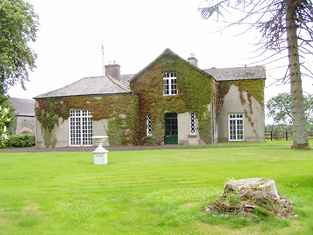
|
| Oldtown | The home of the Bennett family in the 19th century, occupied by Theophilus Bennett in 1814 and by John Bennett in the early 1850s. The property was held from the Cardens and the buildings were valued at £19+ in the mid 19th century. This house was demolished by the early 20th century. | |
| Templemore Abbey/The Priory | In 1837 Lewis refers to the Castle at Templemore being the residence of the Carden family "up to about a century ago" when it was accidentially burnt by fire. He states that more recently the Carden family had lived at the Priory, a house marked on the first edition Ordnance Survey map and valued at £96+ at the time of Griffith's Valuation. This house was rebuilt in the 1860s and was burnt in the early 1920s. The stableyard is still extant. In 1894 Slater had referred to Templemore Abbey as the seat of Sir John C. Carden. |
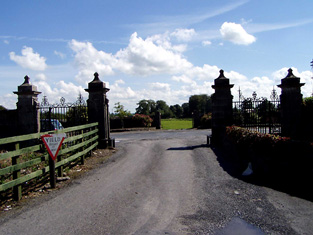
|
| Woodville | The residence of the Webb family in the 19th century. The house was valued at £49+ in the early 1850s, occupied by Captain Daniel James Webb and held from Sir John C. Carden. Still a fine residence just south of Templemore. |
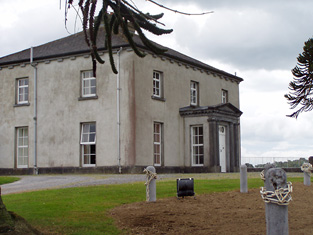
|
| Eastwood | Lewis records Thomas Bennett as the proprietor of Eastwood. James Mason held Eastwood House and 209 acres from Thomas Bennett at the time of Griffith's Valuation. The buildings were valued at £22+. Buildings are still located at this site. | |
| Green Hills | The home of a branch of the Minchin family in the 18th and for part of the 19th centuries. The house was occupied by the Reverend William Minchin in the first half of the 19th century. It was valued at £34.15 shillings at the time of Griffith's Valuation and held in fee. The sale rental of 1851 describes the house as large and commodious and in good repair. Bought by a brother of one of the Reverend Minchin's son in laws Montague Blackett. This house no longer exists. | |
| Barnane | Barnane, at the foot of the Devil's Bit mountain, was the seat of a branch of the Carden family. Occupied by John Carden in 1814 and by R. Carden in 1837. John Carden held the property in fee with 1,430 acres at the time of Griffith's Valuation. Andrew M. Carden was resident at Barnane in 1906 when the buildings were valued at £120. The house is now a ruin. |
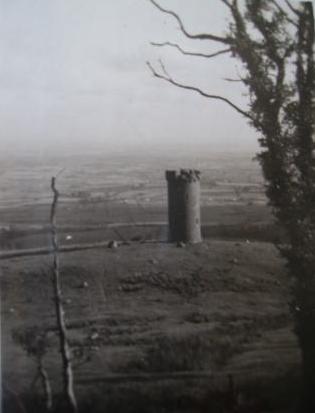
|
| Derrylahan House | This house was the home of the Mason family in the 19th century, occupied by James Mason in 1814 and by William Mason in the early 1850s. The buildings were valued at £10 and held from Peter D. La Touche. William Mason of Derrylahan owned 228 acres in the 1870s. A house and farm are still extant at the site. | |
| Longford | The Ordnance Survey Name Books refer to Robert Lloyd as the proprietor of Longford House in the 1840s and it was occupied by him and held from Thomas Prince Lloyd at the time of Griffith's Valuation when the house was valued at £16. A mansion house in the townland of Longford valued at £34+ was occupied by James Lloyd in 1906. A building is still located at this site. | |
| Mountfrisco | Mount-fresco was occupied by Thomas Lloyd in 1814 and by Horatio Lloyd in 1837 and in the early 1850s. The house was then valued at £10 and held in fee. This house is no longer extant. | |
| Loran Park | The seat of the Roe family in the 19th century, occupied by George Roe in 1837 and in the early 1850s, when the house was valued at £25.10 shillings and held from Henry Minchin. The residence of Ellen Robinson in the mid 1870s. A house and farm are still extant at the site. | |
| Dangansallagh | Lewis records J. Lewis as resident at Dangan Lodge in 1837 and Griffith's Valuation records James Middleton holding the lodge valued at £10+ and 266 acres in fee. It is now a ruin. | |
| Dromard | The home of the Lidwill family, occupied by George Lidwill in 1814 and by Fred Lidwill in 1837 and in the early 1850s. The house was valued at £11 and held from George Goold. In the early 1940s the Irish Tourist Association surveyor described Dromard as a "very pretty building, set amidst well kept grounds and pleasure gardens". The owner was Colonel Robert Lidwell. Dromard House, Templemore, on 253 acres was advertised for sale in ''The Farmers Journal'' (6 Nov 2004) and sold for over 4 million euro in 2006 see http://www.independent.ie/national-news/yesterdays-auction-results-73225.html | |
| Ash Park | Ash Park or Park was the home of the Butler family in the 18th and 19th centuries. Occupied by James Butler in 1814 and 1837 and by Captain James Butler at the time of Griffith's Valuation. The buildings were valued at £35+ and held in fee. This house no longer exists. | |
| Skehanagh | George Lloyd was living in a house valued at £16 at Skehanagh North in the mid 19th century.The Ordnance Survey Name Books note "Skehana" as the residence of George Richard Lloyd in 1840. In the 1870s Horatio M. Lloyd of Skehana, Templemore owned 182 acres in county Tipperary. Catherine Lloyd was resident in 1906. This house burnt down and the present building on the same site dates from the early 20th century. |

|
| Killoskehane | This house was the seat of the Willington family. In 1837 Lewis wrote that Killoskehane Castle "includes part of the ancient castle in the modern mansion". The property was held by John Willington in fee at the time of Griffith's Valuation when the buildings were valued at £29+. Edward D. Martin was the occupier of Killoskehane in 1906 and William Costigan in the 1940s. The building is still extant and occupied. |

|
| Lisduff | The Smiths were resident at Lisduffe from the early 18th century when Jeremiah Lalor married the daughter of Samuel Smith of Lisduffe. From this couple descend the Lalors of Long Orchard. Samuel Smyth was the occupant of Lisduff in 1814 and William Smith in 1837. Griffith's Valuation records John Minchin as resident. The buildings were then valued at £33 and held from Admiral Darby. This house is still a residence. |
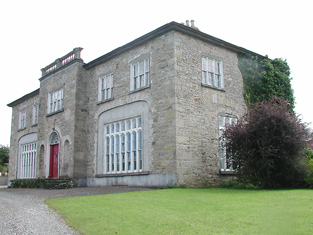
|
| New Grove | Leet and Lewis both record Westropp Smith as the occupier of New Grove, Roscrea, in 1814 and 1837. John Minchin was the occupier at the time of Griffith's Valuation. He held the property, valued at £19, from Henry B. Minchin. A building is still extant at this site. | |
| Mount Dudley | A house close to the town of Roscrea and marked on the first edition Ordnance Survey map. In the mid 19th century occupied by Samuel Dudley, valued at £17 and held with 29 acres from the Earl of Portarlington. The home of Thomas Ely in the 1870s. This house is extant and occupied. |
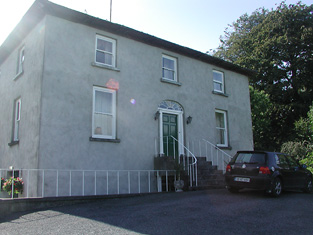
|
| Inane | In 1786 Wilson mentions Inane as the seat of Rev. Curtis. Robert Curtis was the proprietor of Inane, Roscrea, in 1814 and P. Jackson was resident in 1837. By the time of Griffith's Valuation Frederick A. Jackson was the occupier, holding the property in fee. The buildings were valued at £50. There appear to be two houses at Inane, a nine bay house dating from the early 18th century and a 19th century house very closeby. The Jacksons were still resident in the 1870s and the representatives of Henry V. Jackson held the property in 1906. It is still extant. |

|
| Lloydsborough | In 1786 Wilson mentions that Lloydsborough was the seat of Mr. Carden. This house was the seat of the Lloyd family in the 19th century. In 1814 Henry Lloyd was resident and in 1837 John Lloyd was the occupant. Griffith's Valuation records John as holder of the property in fee and the buildings were valued at £44+. Lloydsborough was still in the possession of a branch of the Lloyd family in the early 20th century. Still extant and occupied, Lloydsborough was offered for sale in 2014. |

|
| Cranagh | Located beside a castle of the same name this house was occupied by John Lalor in 1814. Lewis records the property belonging to J. Lloyd but occupied by the Reverend M.N. Thompson. At the time of Griffith's Valuation Cranagh was in use as an Auxiliary Poor House and was valued at £25+. The Irish Tourist Association surveyor refers to a 4 storey house built at Crannagh in 1768 by the Lloyd family. The owner in the early 1940s was J. Cullen. This house is no longer in existence. | |
| Castleleiny | A house occupied by John Lloyd and his wife Debby Ann in the early part of the 19th century. Henry Jesse Lloyd son of the Reverend George Lloyd of Castle Iny and his wife Anne Hely entered the King's Inns in 1840. By the mid 19th century William Healy was the occupant holding the house valued at £12+ from the Earl of Orkney. | |
| Honeymount | Honeymount was occupied by John Evans in 1814 and by Captain Lloyd in the early 1850s, when it was valued at £11.10 shillings and held from Leonard Williams. Robert Lloyd is recorded as the tenant in the sale notice of 1856. Honeymount, part of the estate of the Mahons of Co Clare, was advertised for sale in July 1871. A house is still extant at the site. In 2014 it was offered for sale. |

|
| Monaquil | Burke's ''Landed Gentry of Ireland'' (1904) records Philip Going of Monaquil, sixth son of Robert and Jane Going. In 1767 Philip married Grace Bernard. Their grandson, Reverend Philip Going Atkins Going, succeeded to the Monaquil property by the will of his maternal grandfather, who died in 1820. Monaquil was occupied by the Atkins family in 1837. In 1840 the Ordnance Survey Name Books record that "Mr. O'Shea, proprietor, states that he has nothing to do now ith Monaquil, it is under the Courts" and that the house was then occupied by a Mrs. Bennett. It was vacant at the time of Griffith's Valuation. when Reverend Hastings Atkins was the immediate lessor and the house was valued at £19. The Butler sale rental of 1866 records a fee farm grant dated 19 May 1859, John Butler to Reverend Philip Going Atkins Going. The Atkins sale rental of 1877 records the leasing of Monaquil to Robert William Henry Roe in 1864. The original house marked on the first edition Ordnance Survey Map was replaced by another house slightly to the north in the late 19th century. | |
| Bantis | In 1814 Mr Kennedy is recorded as the proprietor of Bantis and Lewis mentions the extensive brewery of Edward Kennedy at Bantis in 1837. The Ordnance Survey Name Books record Bantis as "a neat dwelling house", the residence of Edward Kennedy. Buildings valued at £31+ and 526 acres at Bantis were held from the Honourable O.F.G. Toler by Edward, James, Denis, John and Patrick Kennedy and Henry Fitzgerald at the time of Griffith's Valuation. A house is still extant at the site. | |
| Lismore | A house on the Toler estate, occupied by John Pepper and valued at £13+ in the mid 19th century. A building is still located at this site. | |
| Lissanisky | The home of a branch of the Pepper family in the 19th century, occupied by Simon Pepper in 1814, by R. Smithwick in 1837. The Ordnance Survey Name Books refer to it as " a good dwelling house, the residence of Mr. Pepper". It was occupied by Theobald Pepper and Brothers in the early 1850s. This house was held from the Honourable O.F.G. Toler and was valued at £25.10 shillings. It is still extant and occupied. |
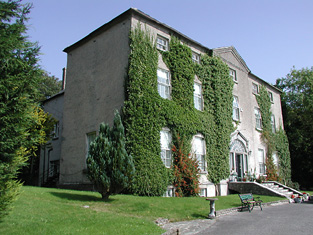
|
| Camira | Occupied by the Reverend P. Bolton in 1837 and by William Jackson in the early 1850s, when the house valued at £11.14 shillings was held from Anne Crawford. In the possession of the Cole Bowen family in the later 19th century. This house no longer exists although a building is still located at the site. http://www.askaboutireland.ie/reading-room/history-heritage/big-houses-of-ireland/the-cole-bowen-estate/bowen-family-history/ | |
| Hermitage | This house was occupied by J.A. [John Andrew] Jackson at the time of Griffith's Valuation and held from his father Major Jackson. The house was valued at £20.16 shillings and was located close to the River Ollatrim. This house was renovated in the early 21st century. |

|
| Mount Pleasant | The main home of the Jackson family in the 19th century, occupied by John Short in 1814, by Captain Jackson in the 1830s and by Major Jackson in the early 1850s. The house with 448 acres was held from John Willington. The buildings were valued at £29+. Francis Freeman was the tenant in 1870. This house no longer exists. | |
| Castle Willington | Castle Willington was the seat of a junior branch of the Willington family of Killoskehane Castle. In 1786 Wilson refers to it as the seat of Mr. Willington. The Ordnance Survey Name Books note it as the seat of James Willington. Valued at £38+ it was held by James Willington in fee at the time of Griffith's Valuation. Alice C. Langford occupied this house valued at £20 in 1906. She was a daughter of John Willington and had married in 1877 Charles C. Coplen Langford. This house of 3 storys with tower house attached is still a residence. |

|
| Donnybrook | This house was the seat of a branch of the Poe family in the 18th and 19th centuries. William Poe was resident in 1814 and Lewis records him as the proprietor but the house was occupied by a tenant. The Ordnance Survey Name Books mention William Jackson as the occupier and describe the house as "large and commodious". At the time of Griffith's Valuation William Poe held the property in fee, the buildings were valued at £16.14 shillings. Donnybrook is still extant. |

|
| Wilton | This house located close to Donnybrook was vacant at the time of Griffith's Valuation and held by William Poe. It was valued at £10+. Earlier, in 1839, the Ordnance Survey Name books had noted it as the residence of John Poe but "out of repair at present". It no longer exists. | |
| Falleen | The home of the Hawkeshaw family in the 19th century, held from the Bowens of Bowens Court. Benjamin Hawkeshaw is recorded as the occupant in 1814 and in the early 1850s when the house was valued at £13.14 shillings. G. Riall was resident in 1837. The Ordnance Survey Name Books refer to Falleen as the seat of James Bennett in 1839. A house is still extant at the site. | |
| Knockane | Knockane was occupied by Mr William Cooke in 1814. In 1840 the Ordnance Survey Name Books describe it as " a commodious house the property of Mr. Hawkshaw". It was the residence of William Hodgens in the early 1850s, when the buildings were valued at £12.17 shillings and held from Robert Cole Bowen. A possibly later house is located at the site now. | |
| Pallas | The home of the Short family in the first half of the 19th century held from the Bowens of Bowens Court. John Short was resident in 1814 and 1837. The Ordnance Survey Name Books describe it as "a commodious dwelling with pretty demesne". It was occupied by Edmund Short at the time of Griffith's Valuation when the buildings were valued at £10. A farm is located at the site. | |
| Bessborough | In 1814 this house was occupied by John Mahon and in 1837 by T. Sadlier junior. The Ordnance Survey Name Books indicate that the proprietor was Mrs. Harding of Dublin and describe Bessborough as " a most beautiful house, occupied by Mr. Cushin, solicitor". By the time of Griffith's Valuation Dr John Armstrong was resident. He held the property from Mrs Harding and the buildings were valued at £20+. Jonathan Harding of Bessborough, Nenagh owned 163 acres in the 1870s. Slater refers to this house as the residence of David E. Young in 1894. It is still in use as a residence. |
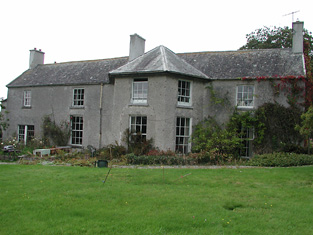
|
| Grenanstown | Wilson refers to Grenan's-town as the seat of Mr. Dalton in 1786. In 1837 Lewis describes Grenanstown as the seat of Count D'Alton. The Ordnance Survey Name Books note that James Williams was leasing Grenanstown but that it was occasionally the residence of Count D'Alton. At the time of Griffith's Valuation James Williams occupied Grenanstown. He held the property from Count D'Alton and the buildings were valued at £19.11 shillings. The National Inventory of Architectural Heritage states that Richard Dalton Williams (1822-1862), poet and Young Irelander, lived here as a child. This house was later the property of Henry Eustace, a member of the Robertstown, county Kildare family. It is now a ruin. |
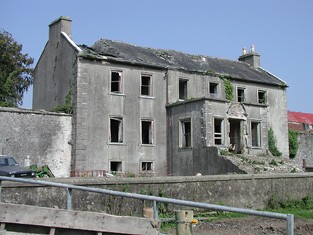
|
| Shanbally | Shanbally was occupied by John Gasson in 1814 but had become the home of Peter Smithwick by 1837. He held the property from Samuel Gason in the mid 19th century when the house was valued at £26.13 shillings. The Ordnance Survey Name Books describe it as "a good dwelling house". In 1894 Slater refers to it as the residence of John Smithwick. It is still extant. |
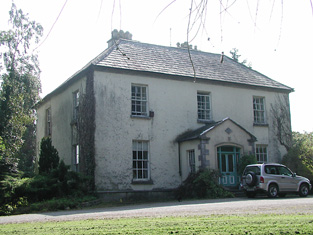
|
| Woodville | Woodville was a home of a branch of the Minchin family from the mid 18th century. The Reverend James Poe was resident at Woodville, Nenagh, in 1814 and Lewis records Humphrey Minchin as the proprietor in 1837. The Ordnance Survey Name Books mention that it had "by far the most beautiful demesne in the parish". He is also recorded as the occupier in Griffith's Valuation when the house was valued at £20.14 shillings and held in fee. When advertised for sale in 1869 James J. Poe was given as the tenant under the Court of Chancery. The house was described as containing a basement story, three large sitting rooms and five principal bedrooms. In 1906 occupied by Alice M.M. Bunbury. George W. Bunbury of Woodville owned 516 acres in the 1870s. |
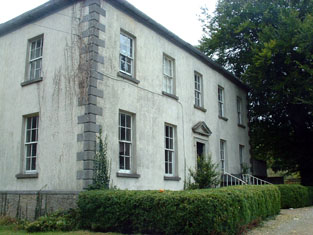
|
| Ballinamona | A house valued at £11+ on the estate of the Honourable O.F.G. Toler and occupied by Newton Short in the mid 19th century. The Ordnance Survey Name Books refer to it as "a good dwelling house" in 1840. A house is still extant at this location. | |
| Islandbawn | Malachi Ryan held a house, offices, flour mill and 76 acres at Islandbawn from the Honourable O.F.G. Toler at Islandbawn in the mid 19th century. The buildings were valued at £85. |
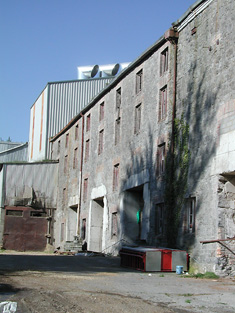
|
| Castle Otway | Castle Otway was the seat of the Otway family in the 18th and 19th centuries. It was a mid 18th century house with a tower house attached, altered and renovated in the 19th century. In the mid 19th century the castle, valued at £47.17 shillings, was held by the Honourable Mrs Otway Cave in fee. The sale rental includes a lithograph of the house. Slater refers to it as the seat of William Otway Ruthven in 1894. The representatives of Robert J. Otway occupied this house in 1906. It is now a ruin. |
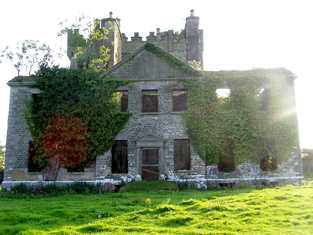
|
| Millbrook | Described by Wilson as the seat of Mr. Hawkshaw in 1786, Millbrok was also the home of the Hawkeshaw family in the 19th century, occupied by Richard Hawkshaw in 1814 and of his representatives in the early 1850s, when it was held from George Armstrong and valued at £19+. Millbrook House was included in the sale of the Earl of Listowel's estate in 1861. Michael Dwyer was the tenant. A building is still located at this site. | |
| Clermont House | Clermont or Claremount House, Nenagh, was occupied by William Short in 1814 and by Frederick Evans in 1837. In 1840 the Ordnance Survey Name Books refer to it as "a good dwelling house, the residence of Mr. J. Evans". It was also occupied by Evans at the time of Griffith's Valuation. The house was then valued at £24 and held from the Marquess of Ormond. This house still functions as a residence. |
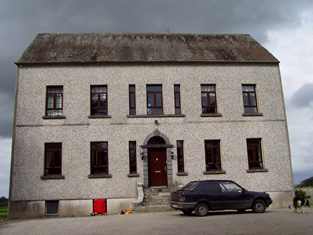
|
| Rathurles | Rathurles was the home of the Brereton family in the 19th century. Occupied by John Brereton in 1814 and T. Brereton in 1837. In 1840 the Ordnance Survey Name Books refer to it as "a modern building". Thomas Brereton was still resident at the time of Griffith's Valuation holding the property valued at £27.15 shillings from Patrick Kernan. Home of Hugh Finch in the 1870s. This house is still extant and occupied. |
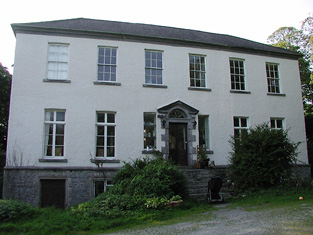
|
| Norwood | In 1841 the Ordnance Survey Name Books described Norwood as "a good dwelling house occupied by a member of the Minchin family" though Simpson Hackett is noted as the proprietor. Captain David Joyce was resident in the mid 19th century when the house was valued at £15+ and held from Thomas Hackett. This house is still extant. |
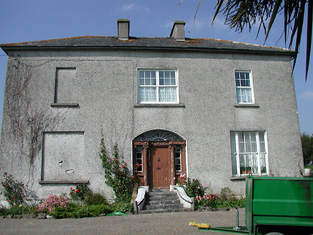
|
| Ballyquiveen | A house built post the first edition Ordnance Survey map of circa 1838. John Brindley was leasing a house from Dean Head valued at £5+ at Ballyquiveen at the time of Griffith's Valuation. It is no longer extant. | |
| Beechwood Park | Beechwood, near Nenagh, was occupied by Richard C. Langford in 1814 and Lewis writes that Beechwood was the property of Colonel Toler Osborne but was occupied by D. Falkiner and had once been the residence of the Earl of Norbury. Wilson, writing in 1786, refers to "Beech Wood, the fine seat of Daniel Toler". In the mid 19th century William Osborne was resident, holding the property in fee. The buildings were valued at £33. Occupied by Lady Osborne in 1906 when the buildings were valued at £40+. The home of Philip Blake, genealogist, in the mid 20th century. This mid 18th century house still functions as a country house. |
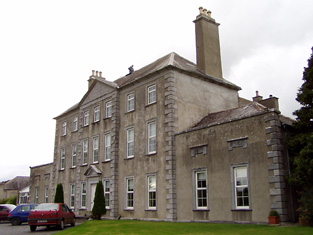
|
| Behamore | The Reverend Thomas Hawkshaw was resident here in 1814 and Benjamin Hawkshaw in 1837. The Ordnance Survey Name Books also note it as his residence, describing Behamore as "a commodious house". James Fleetwood was the occupier in the early 1850s holding the property from Lord Dunalley, it was valued at £13+. A building is still located at this site. | |
| Northland | Northland was the residence of Sir A. Dancer in 1814 and of William Smith in 1837. By the time of Griffith's Valuation William Henry Head occupied this house valued at £10. He held the property from Lord Dunalley. The house was demolished by the early 20th century. | |
| Willow Lodge | James Fleetwood was resident at Willow Lodge in 1814 and in 1837. By the time of Griffith's Valuation the house appears to be only valued at £1 and occupied by David Tierney. Willow Lodge is marked on the first edition Ordnance Survey map. It is named Alma on the 25-inch map of the 1890s. There is still an extant house at the site. | |
| Deer Park | Lewis records Park House as the property of William Trench but the residence of De La Pere A. J. Robinson. The Reverend Frederick F. Trench was the occupier in the mid 19th century, holding the house valued at £23 from Lord Dunalley. This house still functions as a residence. |

|
| Cloghjordan House | This house was the home of the Reverend Edwin Palmer in 1814. By the time of Griffith's Valuation John Hodgins occupied the house and ran the nearby nursery gardens. The buildings were valued at £13+ and held from Lord Dunalley. This building which includes the remains of the old castle still functions as a country residence. |
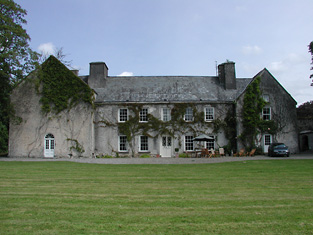
|
| Tenessee | This house is labelled Tenessee House on both the First and 25-inch edition Ordnance Survey map. In 1841 the Ordnance Survey Name Books suggest that it was the property of Lord Dunally. In the mid 19th century it was occupied by Thomas R. Barnes and held from Joseph Falkiner. The buildings were valued at £14. 15 shillings. The house is still in use as a residence. |

|
| Coolnamunna | At the time of Griffith's Valuation Edward Kennedy held buildings valued at £34+ from Ellen Lloyd [widow of Henry Jesse Lloyd of Castle Iney?] in the townland of Coolnamunna. He had a distillery in Mullenkeagh valued at £47. Edward Kennedy of Coolnamoner Park owned 432 acres in county Tipperary in the 1870s. |
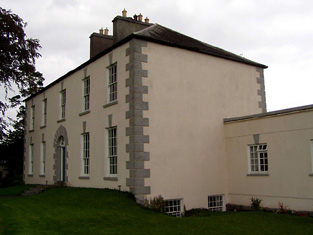
|
| Glenahilty | William Kennedy was occupying Glenahilty from at least 1837 when Lewis records him as resident althought the property belonged to J.C. Fitzgerald. The house was valued at £6.10 shillings at the time of Griffith's Valuation and was held with 189 acres of land and 210 acres of bog from Fitzgerald. | |
| Hilton | Hilton, located just to the south of Modreeny House, was the home of Thomas Dancer, later 6th Baronet, in 1837 and of the 6th Baronet's son, Thomas J. Dancer, in the mid 19th century. Thomas J. Dancer held the house valued at £15 from his father Sir Thomas B. Dancer, 6th Baronet. In 1841 the Ordnance Survey Name Books had noted the house as the residence of Thomas Stoney. A house is still located at this site. | |
| Elysium | This house is marked on the first edition Ordnance Survey map and was inhabited by Thomas Ely in 1837. Thomas Ely held the property in fee at the time of Griffith's Valuation when the house was valued at £23. The Elys were still resident in the 1870s. George Evans was occupying this house in 1906. There is still a house located at this site. | |
| Modreeny | Lewis records W. H. Head as the proprietor of Modreeny House in 1837. He was still resident at the time of Griffith's Valuation and held the house valued at £35 in fee. Burke's ''Landed Gentry of Ireland'' (1904) records William Henry Head's father as "of Modreeny House". In 1906 the representatives of George Whitfield were the occupiers and the house was valued at £36.10 shillings. George Whitfield of Modreeny owned 443 acres in the 1870s. In 1890 his daughter Kathleen married Sir Francis Osborne, Baronet. This house was bought by Donald Swan in 1965 and Charlie Swan, champion jockey, was born at Modreeny in 1968. |
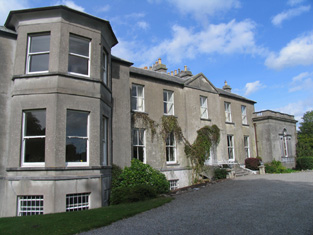
|
| Aghsmear | This house is not marked on the first edition Ordnance Survey map. Griffith's Valuation records a house of £4.5 shillings valuation occupied by Dr Patrick Cleary and held from Joseph Griffith. Joseph Griffith lived at Aghsmear in the 1870s and he was still resident in 1906 when the mansion house was valued at £22+. |
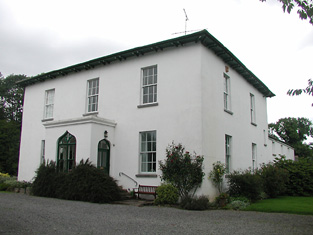
|
| Killough (Templemore) | Cottage type house built 1880. In 1906 Richard J. Lloyd is recorded as the occupier of a mansion house valued at £27+ in the townland of Killough. |
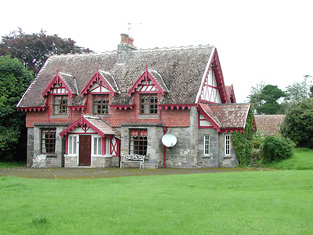
|
| Dovea (Killahara) | A house built in the late 19th century and occupied by Major Fitzgibbon Trant in 1906 when the buildings were valued at £31+. Lewis writes that there was “a very fine old castle” at Killahara, which formerly belonged to Purcells but was then (1837) the property of Mr Trant. |

|
| Ballinlonty | Lewis records M. Fogarty as resident in 1837. In 1840 it is described by the Ordnance Survey Name Books as "a genleman's house" though the resident's name is not recorded. The house, valued at £9.10 shilling was held by Frederick J. Fegan in fee at the time of Griffith's Valuation. This house is no longer occupied. | |
| Sorrellhill | James Bennett was resident at Sorrel-hill, Templemore in 1814. This house is marked on the first edition Ordnance Survey map but looks larger in size on later maps. At the time of Griffith's Valuation, valued at £16.10 and held by Dudley Byrne from Philip Gowan. This house is still extant. | |
| Ballymackey House | Ballymackey House is described as "in ruins" at the time of the first Ordnance Survey in the 1830s. An earlier tower house is also shown, described as "Ballymackey Castle (in ruins)". Wilson, writing in 1786, refers to "Ballymakey" as the seat of Mr. O'Meara. The Ordnance Survey Name Books describe Ballymackey House as "an old house adjoining the south side of Ballymackey old castle.....now in a state of total ruin". By the time of Griffith's Valuation, this townland was part of the Cole-Bowan estate. Most of the site is now occupied by extensive farm sheds though ruins of the old castle are still visible. | |
| Tiermoyle House | In 1786 Wilson refers to Tiermoyle as the seat of Mr. Crawford. In 1840 the Ordnance Survey Name books refers toTiermoyle as a residence of Cooper Crawford and "about 20 years ago it was then a place of some account but it is now in a state of dilapidation". By the time of Griffith's Valuation, this house was occupied by Mrs. Costelloe, leasing from Countess Norbury's estate and valued at almost £4. A farm is still extant at the site. | |
| Elm Hill House | The Ordnance Survey Name Books record William Middleton as the occupier of Elm Hill House in 1839 and mention the surroundings as "a very pretty demesne situated in a beautiful locality". At the time of Griffith's Valuation, William Middleton was leasing this property from the Poe estate when the house was valued at almost £8. The original house is no longer extant and a modern house has been constructed at the site. | |
| River Lawn | In 1839, he Ordnance Survey Name Books describe River Lawn house as "a commodious house, the property of William Poe, in the occupation of E. Radford esq". At the time of Griffith's Valuation, when it was valued at almost £10 it was leased by Augustus H. Going from William Poe. It is still extant and occupied. |
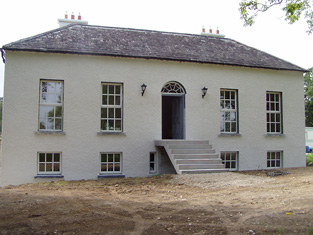
|
| Mill Grove House | In 1841, the Ordnance Survey Name Books describe Mill Grove House as " a good house with demesne and plantations, the residence of Mr. Kennedy". At the time of Griffith's Valuation, Edward Kennedy was leasing a substantial milling complex and a house at this location from the Stoney estate. The buildings had a value of £46+. It is labelled Millgrove House on the 25-inch map of the 1890s but is no longer extant. | |
| Ballycrenode House | In 1840 the Ordnance Survey Name Books refer to the site of Ballycrenode House in the parish of Kilkeary, stating "only those people who are very old can recollect seeing any part of this house standing". This original Ballycrenode House belonged to the O'Carroll family and the last inhabitant was a Major O'Carroll. The site is marked on the 1st edition Ordnance Survey Map. At that time and in Griffith's Valuation, the townland belonged to the Toler estate. The 25-inch map of the 1890s shows a later Ballycrenode House, located slightly to the north-west of the original site. This property is still extant, part of a large farm. | |
| Riversfield (Upper Ormond) | In 1840 the Ordnance Survey Name Books record Riversfield as " a neat house, the residence of Mr. John Ardill". He was leasing it and the adjoining mills from Mrs.Otway Cave's estate at the time of Griffith's Valuation, when the buildings were valued at £17+. A house and farm buildings are still extant at the site. | |
| Butler's Lodge | In 1840 the Ordnance Survey Name Books refer to Butler's Lodge as "a gentleman's seat" in the townland of the same name. The house is labelled as Butler's Lodge on the 1st edition Ordnance Survey map but is not labelled on the 25-inch edition of the 1890s. At the time of Griffith's Valuation it was valued at over £5 and part of the estate of Edward Cambie. A modern house occupies the site now. |

